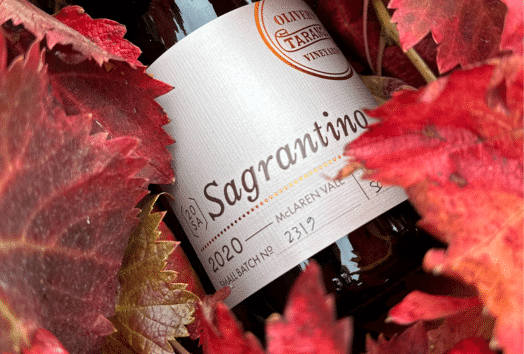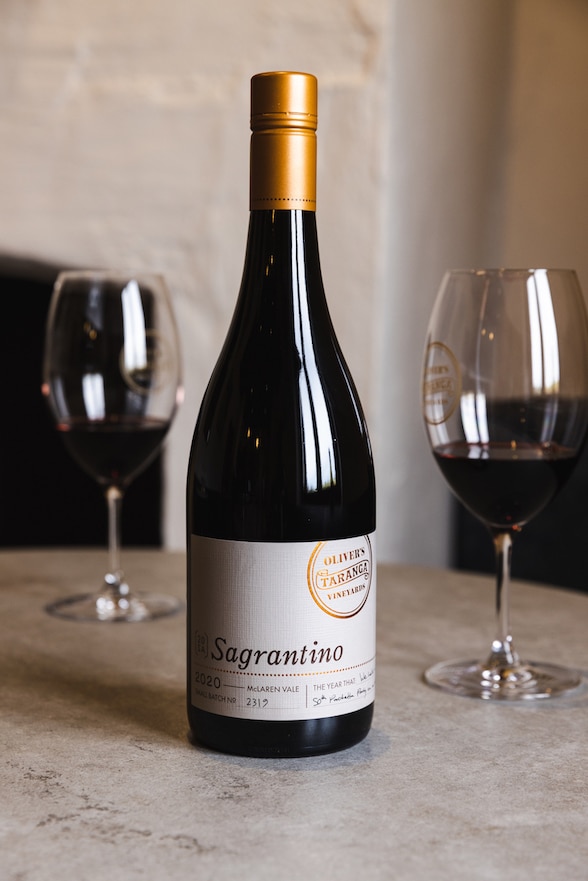
Sagrantino is back at Oliver’s Taranga, just in time for this weekend’s Tasting Australia Porchetta Party!
And after a couple years without it, the 2020 vintage is certainly worth the wait. A very low cropping year with lots of warmth, it was perfect for ripening the delicious and voluminous Sagrantino tannins, but at almost half the quantity we last made in 2017, there are only limited quantities of this one available, so if this is your jam, get in quick!
If you haven’t tried Sagrantino before, make time for this delightful, medium-bodied wine. Originally from Umbria, in central Italy, Sagrantino is a wine of beautiful, intense, floral tannins, loads of savoury chinotto and cherry licorice fruit burst flavours, but it is the intensity of tannins that sets this variety apart.
Best enjoyed over a shared meal with friends, it finds a welcome friend in Italian Porchetta. In fact it was this wine that inspired us to start our iconic Porchetta Parties (next one is 25th June). Synonymous for many with McLaren Vale, these events even achieved National Geographic ‘World’s Best Food Destinations’ status in 2019. If you haven’t been to one, you haven’t lived!
So don’t delay, head on over and grab a bottle or 12 of the 2020 Sagrantino before it’s all gone!
And if you’re still not sure, let’s hope this great review inspires you to try it…
“Sagrantino is a sturdy grape from Italy’s Umbria region, amped with a ferocity of tannic mettle, a sachet of dried herbs that pour across the palate and an intensity of ferruginous earth, dark-fruit allusions and cherry liqueur. But fear not, this has been extracted with aplomb, gently and almost pulpy. The oak is nestled amidst the fray as a brake of restraint rather than a clutch of amplitude. Yet the tannins, sooty and granular, molten and dark, define the finish. Demands food rich in iron and protein as a salve. Impressive.“
93 POINTS Ned Goodwin MW, HALLIDAY WINE COMPANION
How did we start our journey with Sagrantino?
The Oliver’s Taranga journey with Sagrantino began more than 20 years ago now, when bright eyed and bushy tailed Mark Lloyd from Coriole and Chester Osborn from d’Arenberg spent a bit of time in Italy scoping some varieties that may have potential in McLaren Vale. They were inspired to visit the home of Sagrantino in Montefalco, Umbria by the late great Greg Trott of Wirra Wirra, after many evenings of pizza and Sagrantino di Montefalco at the iconic Russells Pizza in Willunga. Oh, to have been at those dinners! But we digress.
Having enjoyed the wines they found in Montefalco immensely, but having run out of plantable land at the time, Mark & Chester requested that Oliver’s Taranga plant some Sagrantino for them to purchase under contract. At the time more than 60% of our 300 acre vineyard was planted to Shiraz, so Sagrantino was a significant departure from the norm, and an exciting journey to embark upon.
The variety had been in Australia for a couple of years. The Chalmers family bought it in from Italy via their relationship with the Matura Group, and had planted it in their Euston vineyard on the NSW/VIC border. There was very little information available on the variety, given that it is rare, even in Italy. Grown in Montefalco, Umbria, it had been made into a sweet passito style wine used in religious ceremony for centuries, but in 1992 was granted DOCG status as a dry red wine. This resulted in somewhat of a rebirth for the variety, of which only a small number of plantings remained. Sagrantino vineyards are now thought to be close to 300 acres, but still only make up around 6% of the grape production of Umbria. In 2004, after sourcing the vine cuttings from Chalmers Nurseries, we planted the first Sagrantino in our vineyard on the corner of Olivers & Osborn Road in McLaren Vale.
We discovered very quickly that Sagrantino was very slow growing, but after 2 years trying to establish the vines, and having very slow results, Don (our viticulturist) travelled to Montefalco to meet with growers in the homeland of Sagrantino. He discovered that they were generally pruning to only one bud, and were planted at much higher densities than we had done. When discussion turned to the sluggish growth, Don was informed by a number of growers to “Just be patient!” While they acknowledged the impact of the virus, most informed that the ‘clean’ stocks were not popular with the local winemakers at all, and warned against going down this path.
Eventually the vines established and produced their tiny first crop in 2007, giving solid results for both Coriole and d’Arenberg’s resultant wines. Unfortunately, the 16 day heat wave of 2008 resulted in the fruit cooking on the vine, and it was not picked. So it wasn’t until 2009 that we had the chance to experiment with the variety again, and by this stage, we decided that Oliver’s Taranga would also have a crack at making a Sagrantino under our ‘small batch’ label.
A typical bunch of Sagrantino is quite small, with very small, round, thick-skinned berries that are compact within the bunch. They have the look of Cabernet berries, but more red-purple in colour, with a significant bloom on the skin. The growth of the vine is not vigourous, hence the canopy is quite sparse and tends towards yellow-green in colour. In Autumn, the leaves are particularly spectacular- turning a vibrant, almost fluorescent red, and becoming the subject of many a painters brush or photographers lense! It is not uncommon to see numerous cars pulled over with people checking out the vineyard or setting up an easel.
Sagrantino tends to ripen relatively late in our region, but the most striking thing about the Sagrantino grape is its extraordinary level of tannin in the skins and its high natural acidity. It is truly challenging to get your head around when you first taste the variety on the vine. It is this high tannin, high acid character that drives the winemaking choices made when turning the fruit into wine.
Now with many vintages with Sagrantino behind us, we have worked on a number of trials in the winery. Everything from traditional fermentation, to significant extended skin contact, and many things in-between. We are now feeling a little more confident with the management of the tannins, and have come to a happy place by splitting the ferment. It does need some time in barrel to allow the tannins to develop. In Montefalco, there is a minimum aging required to meet the DOCG regulations of 30 months, and the wines have been known to age for decades.
It has been very interesting introducing our customers to this wine in our cellar door. Most successful has been teaming up with Italian food such as our Porchetta Parties. The tannin structure of Sagrantino screams out for food and these fun events are the perfect occasion for people to try something new.
We must be doing something right because every year more and more of our OTT members are asking for this wine. We can certainly see a long future ahead with Sagrantino, and introducing it to many more people in the years ahead.
Corrina, Brioni, Sam and the OT Team
